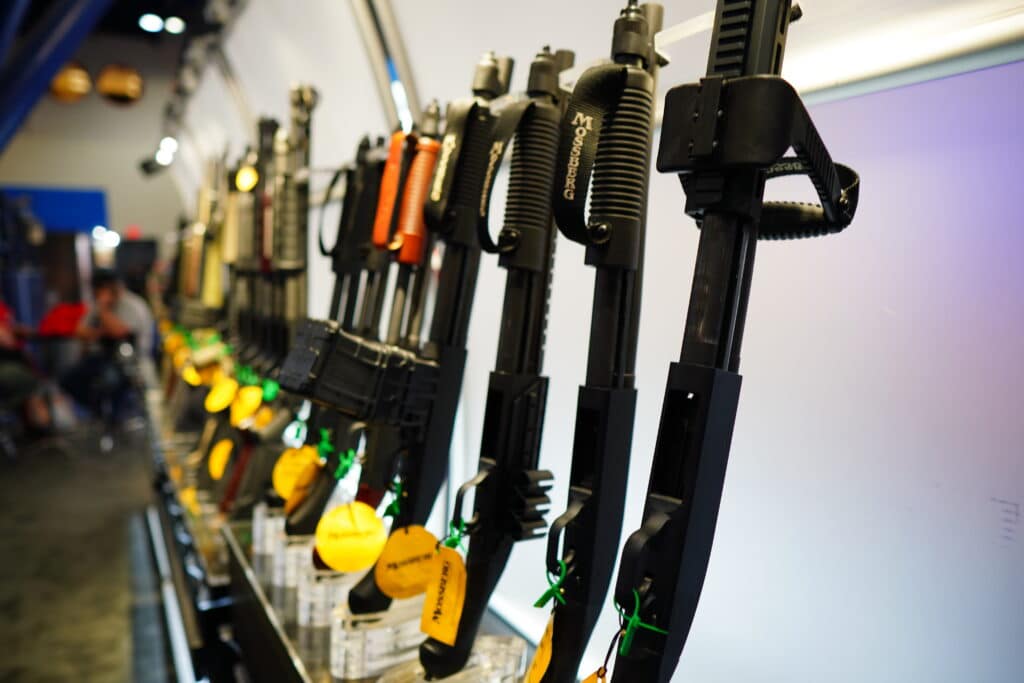Texas just made a move on short-barrel firearms that seems strange at first glance.
Legislatures just legalized them at the state level, even though it doesn’t really change anything in practice. At least, not yet. I explain how the move fits into Congress’s budget bill and why other states may need to copy it.
Then, I take an exceptionally deep dive into the Supreme Court’s burgeoning “dangerousness” standard for disarming people and why a recent non-violent felon’s case raises complex questions about it.
Plus, GOA’s Sam Paredes joins the podcast to explain how the group’s lawsuit led to ATF updating a gun-carry permit policy.

Analysis: What Does Texas ‘Legalizing’ Sawed-Off Shotguns Actually Accomplish? [Member Exclusive]
By Stephen Gutowski
This week, the Texas legislature made a curious move on gun policy.
They sent SB 1596, a short-barrel shotgun and rifle legalization bill, to Republican Governor Greg Abbott’s desk, where he’s likely to sign it. But that legalization is less expansive than people might assume. That’s because it only impacts state law, and Texans will still have to comply with federal short-barrel firearm regulations.
However, it may end up as something more than a symbolic act because of what’s going on in Congress. And it is an initiative gun-rights activists will need to recreate in a number of other states if they want silencer deregulation to stick.
That’s because Texas’s law is similar to many others around the country. As is often the case with many gun laws, Texas regulations on short-barrel guns mirror federal regulations. In this case, Texas law outlaws possession of short-barrel shotguns and rifles unless they are registered with the ATF under the National Firearms Act (NFA).
Therefore, if Congress removes short-barrel firearms from the purview of the NFA, that will cause serious legal problems for owners in Texas. If it becomes impossible to register short-barrel guns with the ATF, it becomes impossible to legally possess them in Texas without this change.
Delisting short-barrel shotguns and rifles from the NFA is not part of the reconciliation package that made it through the House of Representatives last week. However, it is something all of the major gun-rights groups are working to get added into the bill as it makes its way through the Senate over the next few weeks.
While it’s far from guaranteed delisting any kind of firearm from the NFA as part of the GOP’s budget bill, if it does end up happening, Texans won’t be caught off guard. There won’t be a scramble to update state law to ensure lawful gun owners don’t suddenly become criminals by no fault of their own.
Of course, this foreshadows a bigger problem.
Though short-barrel gun delisting didn’t make it into the House budget bill, delisting silencers did. But they face the same potential hurdle as short-barrel firearms. Some states require owners to hold an NFA registration in order to legally possess silencers under state statute.
Not every state operates this way, but quite a few of them do. Some pretty populous ones, too. Colorado and Arizona are examples.
Of course, some gun-rights groups have already thought about this problem. The American Suppressor Association is backing several bills similar to the one in Texas. In fact, the bill in Arizona has already passed the House.
So, in the end, Texas isn’t really legalizing short-barrel shotguns or rifles in the layman’s sense. They’re already legal to own in the state, after all. What legislators are actually doing will ensure that remains the case even if Congress delists the firearms from the NFA.
Gun-rights advocates will have to work on getting other state lawmakers on board. It should be a relatively low-stakes ask. If the delisting effort in Congress fails, nothing practical about the legality of silencers or short-barrel firearms changes. If it succeeds, states that preemptively change their laws can avoid a potential bit of chaos.
Podcast: GOA’s Sam Paredes on the ATF Changing Course of Background Check Bypass Permits [Member Early Access]
By Stephen Gutowski
This week, we’re talking about an under-discussed part of federal gun law and a significant recent update to it.
While most gun owners know you need to pass a background check to buy a gun from a licensed dealer. And most also know you need to pass one to get a concealed carry license. But many don’t know their concealed carry license can be used to bypass the sales background check requirement–at least, in certain states.
That list of states got longer this week as the result of a Gun Owners of America (GOA) lawsuit and President Donald Trump’s executive review of gun policy. Now, 30 states have “Brady Permits” that allow holders to bypass the sales check.
GOA’s Sam Paredes joins the podcast to walk through the years-long legal fight. He lays out how GOA plans to lobby states to change their laws to qualify for the alternative status. He also said GOA plans to file follow-up suits to get ATF to recognize even more permits.
You can listen to the show on your favorite podcasting app or by clicking here. Video of the episode is available on our YouTube channel. An auto-generated transcript of the show is here. Reload Members get access on Sunday, as always. Everyone else can listen on Monday.
Plus, the Tenth Circuit rules on the other kind of domestic violence restraining order that triggers a gun ban. However, it comes to the same conclusion that the Supreme Court did in US v. Rahimi: the ban doesn’t violate the Second Amendment. The ATF also announced two significant moves, one replacing their “zero tolerance” dealer inspection policy and another expanding “Brady permits.”

Analysis: Will SCOTUS Find This Non-Violent Felon Too Dangerous to Own Guns? [Member Exclusive]
By Stephen Gutowski
A Second Amendment challenge from a particularly interesting non-violent felon may soon end up at the Supreme Court of the United States (SCOTUS).
Earlier this month, an En Banc panel of the Ninth Circuit upheld Steven Duarte’s conviction for possessing a firearm as a felon. Duarte is another defendant who claimed the non-violent nature of his prior convictions meant the federal prohibition is unconstitutional as applied to him. Unlike challenges from people like Brian Range, who lied about his income to get food stamps in the 1990s, or Zackey Rahimi, who was subject to a restraining order over numerous violent domestic incidents, Duarte’s case isn’t nearly as clear-cut.
That’s because Duarte’s record includes offenses like drug dealing and running from police in a car. Though his crimes were non-violent, the Supreme Court may still determine his offenses make him dangerous enough to disarm.
The Ninth Circuit’s ruling doesn’t seem particularly helpful in figuring out where SCOTUS might go in the case, though. Instead of trying to determine whether Duarte’s criminal record made him too dangerous to own guns, it simply found his status as a felon was enough justification. It started by citing the Supreme Court’s dicta on felons in Heller, Bruen, and Rahimi, arguing they bolstered the idea that felon gun bans are constitutional.
“Together, these repeated and consistent ‘assurances’ make clear that felon-in-possession laws, like § 922(g)(1), are presumptively constitutional, demonstrating that our holding in Vongxay remains consistent with the Supreme Court’s articulation of Second Amendment rights,” Judge Kim McLane Wardlaw wrote for the majority in US v. Duarte.. “Further, these ‘assurances’ recognize a historical tradition of firearm regulation that supports the categorical application of § 922(g)(1) to felons like Duarte.”
It then concluded the government doesn’t need to show Duarte’s particular crimes establish that he’s individually dangerous in order to disarm him. Rather, it held the government could make that determination merely because he is a felon.
“To support the application of § 922(g)(1) to Duarte, the Government proffers a variety of historical sources that evince two regulatory principles that: (1) legislatures may disarm those who have committed the most serious crimes; and (2) legislatures may categorically disarm those they deem dangerous, without an individualized determination of dangerousness,” Wardlaw wrote. “We address each in turn, and agree that either supplies a basis for the categorical application of § 922(g)(1) to felons.”
However, numerous Supreme Court justices have already shown skepticism of the idea that the government can deem groups of people, even convicted criminals, as prohibited from owning guns absent some sort of dangerousness finding. In US v. Rahimi, several justices took issue with the Department of Justice’s initial argument that the government could disarm people based on the idea they were “irresponsible” or not “law-abiding.”
“It seems to me that the problem with responsibility is that it’s extremely broad, and what seems irresponsible to some people might seem like, well, that’s not a big deal to others,” Roberts noted in oral arguments.
Instead, SCOTUS ruled Rahimi’s disarmament could stand because the domestic violence restraining order he was subject to included a finding that he was dangerous. They repeatedly referenced the idea that Rahimi’s individual record, which included a slew of alleged firearms offenses and acts of violence against the mother of his children, showed he was a physical threat to others. That, they wrote, was a key determining factor in whether he could be disarmed–at least, temporarily.
“When an individual poses a clear threat of physical violence to another, the threatening individual may be disarmed,” Chief Justice John Roberts wrote for the 8-1 majority. “Section 922(g)(8) is by no means identical to these founding era regimes, but it does not need to be. Its prohibition on the possession of firearms by those found by a court to present a threat to others fits neatly within the tradition the surety and going armed laws represent.”
The key takeaway was how much emphasis the Justices put on whether somebody was “a credible threat to the physical safety of others.”
Of course, the majority didn’t opine a whole lot on what specifically makes somebody a credible threat to other people’s physical safety. Roberts seemed to sum up the Court’s view in oral arguments when he asserted, “Well, it means someone who’s shooting, you know, at people. That’s a good start,” which was an allusion to one of the many accusations against Rahimi.
Justice Clarence Thomas, the lone dissenter in the case, argued against the entire concept of the government being able to strip away a group of people’s gun rights by deeming them dangerous. He argued pre-American arms bans against those considered “dangerous” were most often used to target political and religious dissenters as part of tyrannical repression efforts. He said American arms protections were a direct result of that persecution.
“At first glance, these laws targeting ‘dangerous’ persons might appear relevant,” he wrote. “After all, if the Second Amendment right was historically understood to allow an official to disarm anyone he deemed ‘dangerous,’ it may follow that modern Congresses can do the same. Yet, historical context compels the opposite conclusion. The Second Amendment stems from English resistance against ‘dangerous’ person laws.”
Justice Thomas warned that granting the government wide latitude to disarm people it deems dangerous can, and has, led to repression even in the United States. He noted the government had earlier in the case cited arms bans for native Americans and slaves to bolster its argument that groups deemed a threat to society can be disarmed.
“Far from an exemplar of Congress’s authority, the discriminatory regimes the Government relied upon are cautionary tales,” he wrote. “They warn that when majoritarian interests alone dictate who is ‘dangerous,’ and thus can be disarmed, disfavored groups become easy prey. One of many such examples was the treatment of freed blacks following the Civil War.”
Still, Thomas conceded that some people can be disarmed–perhaps even Rahimi himself under the proper proceedings.
“This case is not about whether States can disarm people who threaten others,” he wrote. “States have a ready mechanism for disarming anyone who uses a firearm to threaten physical violence: criminal prosecution. Assuming C. M.’s allegations could be proved, Texas could have convicted and imprisoned Rahimi for every one of his alleged acts. Thus, the question before us is not whether Rahimi and others like him can be disarmed consistent with the Second Amendment. Instead, the question is whether the Government can strip the Second Amendment right of anyone subject to a protective order—even if he has never been accused or convicted of a crime. It cannot.”
Justice Amy Coney Barrett didn’t write at length about “dangerousness” in her Rahimi concurrence, but she did reference an earlier case where she went in depth on the topic.
In 2019’s Kanter v. Barr, Barrett argued a man convicted of felony mail fraud could not be disarmed under the Second Amendment. She based that conclusion on the idea that a person’s Second Amendment rights can only be stripped away if they are an actual danger to others.
“History is consistent with common sense: it demonstrates that legislatures have the power to prohibit dangerous people from possessing guns. But that power extends only to people who are dangerous,” Barrett wrote in a dissent. “Founding-era legislatures did not strip felons of the right to bear arms simply because of their status as felons. Nor have the parties introduced any evidence that founding-era legislatures imposed virtue-based restrictions on the right; such restrictions applied to civic rights like voting and jury service, not to individual rights like the right to possess a gun. In 1791—and for well more than a century afterward—legislatures disqualified categories of people from the right to bear arms only when they judged that doing so was necessary to protect the public safety.”
She highlighted the role violence played in the determination of whether somebody could be disarmed, especially in the case of Kanter.
“Neither Wisconsin nor the United States has introduced data sufficient to show that disarming all nonviolent felons substantially advances its interest in keeping the public safe. Nor have they otherwise demonstrated that Kanter himself shows a proclivity for violence,” she wrote. “Absent evidence that he either belongs to a dangerous category or bears individual markers of risk, permanently disqualifying Kanter from possessing a gun violates the Second Amendment.”
Still, Barrett did infer that violent convictions were not the only thing that could justify disarming somebody under the Second Amendment. She also pointed to the possibility that those who are a threat to public safety could have their guns taken away. She even argued that group extends beyond convicts.
“The historical evidence does, however, support a different proposition: that the legislature may disarm those who have demonstrated a proclivity for violence or whose possession of guns would otherwise threaten the public safety,” Barrett wrote. “This is a category simultaneously broader and narrower than ‘felons’—it includes dangerous people who have not been convicted of felonies but not felons lacking indicia of dangerousness.”
Ultimately, she said the key determining factor was whether somebody represented a genuine threat to the public.
“In sum, founding-era legislatures categorically disarmed groups whom they judged to be a threat to the public safety,” Barrett wrote. “But neither the convention proposals nor historical practice supports a legislative power to categorically disarm felons because of their status as felons.”
Lower courts have weighed in on the question as well, often coming to different conclusions.
US District Judge Carlton Reeves, an Obama appointee, dismissed a felon-in-possession of a firearm prosecution against a violent felon in June 2023. He noted a previous judge found the defendant was no longer a clear threat to others after serving decades in prison for a “bar fight” where he’d killed someone. He then argued there was little in the historical record to justify disarming even violent felons–at least, those similarly situated to the defendant in the case.
“The government’s arguments for permanently disarming Mr. Bullock, however, rest upon the mirage of dicta, buttressed by a cloud of law review articles that do not support disarming him,” Judge Reeves wrote in United States v. Bullock. “In Bruen, the State of New York presented 700 years of history to try and defend its early 1900s‐era gun licensing law. That was not enough. Bruen requires no less skepticism here, where the challenged law is even younger.”
Shortly after that ruling, a Sixth Circuit panel adopted its own test in a case over a man previously convicted of armed robbery.
“[W]e hold today that § 922(g)(1) is constitutional on its face and as applied to dangerous people,” Judge Amul Thapar wrote for the majority in US v. Williams. “Our nation’s historical tradition confirms Heller’s assumption that felon-in-possession laws are ‘presumptively lawful.’ The history reveals that legislatures may disarm groups of people, like felons, whom the legislature believes to be dangerous—so long as each member of that disarmed group has an opportunity to make an individualized showing that he himself is not actually dangerous.”
Thapar developed one of the more comprehensive tests for determining dangerousness in that opinion. He broke the question down into three parts.
“A person convicted of a crime is ‘dangerous,’ and can thus be disarmed, if he has committed (1) a crime ‘against the body of another human being,’ including (but not limited to) murder, rape, assault, and robbery, or (2) a crime that inherently poses a significant threat of danger, including (but not limited to) drug trafficking and burglary. An individual in either of those categories will have a very difficult time, to say the least, of showing he is not dangerous,” he wrote. “A more difficult category involves crimes that pose no threat of physical danger, like mail fraud, tax fraud, or making false statements.”
He argued courts should look at the “unique circumstances of the individual” and “details of his specific conviction” to decide if they fall into the dangerous category. He also said courts should look at a defendant’s entire criminal record and not “just the specific felony underlying his section 922(g)(1) prosecution” before making that decision.
Duarte’s drug-dealing conviction would seem to put him within Judge Thapar’s definition of a “dangerous” person who can be disarmed, but not Judge Reeves. How would his record fit with the one Roberts or Barrett has in mind, though? What would Thomas make of his criminal convictions? Would any of the liberal justices side with him if it meant expanding gun rights to more convicted felons?
It’s hard to say for sure.
Of course, there’s another key underlying question to all of this. Will SCOTUS take up this case at all? Or any other like it?
Lately, that’s seeming less and less likely. The Department of Justice is actively trying to keep SCOTUS from considering as-applied challenges to the federal felon-in-possession law. It has even declined to appeal Range’s case, even though that leaves a circuit split in place.
SCOTUS itself hasn’t shown an appetite for taking up these challenges either. After granting, vacating, and remanding a number in the wake of Rahimi, the Court has consistently denied other cases from various people who are prohibited from owning guns.
Who knows when the Court will take a straightforward non-violent felon case, let alone a more complex one like Duarte’s challenge.
That’s it for now.
I’ll talk to you all again soon.
Thank you,
Stephen Gutowski
Founder
The Reload







